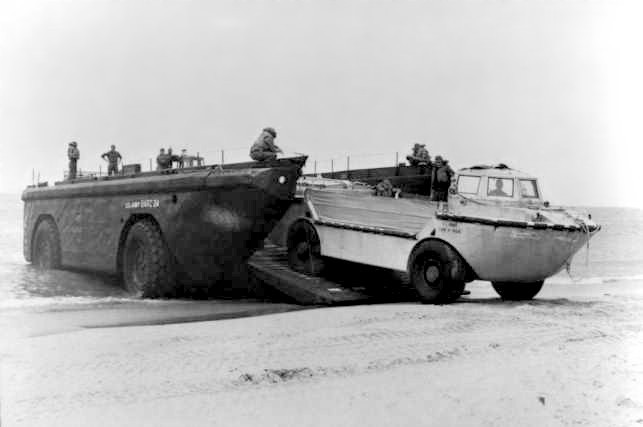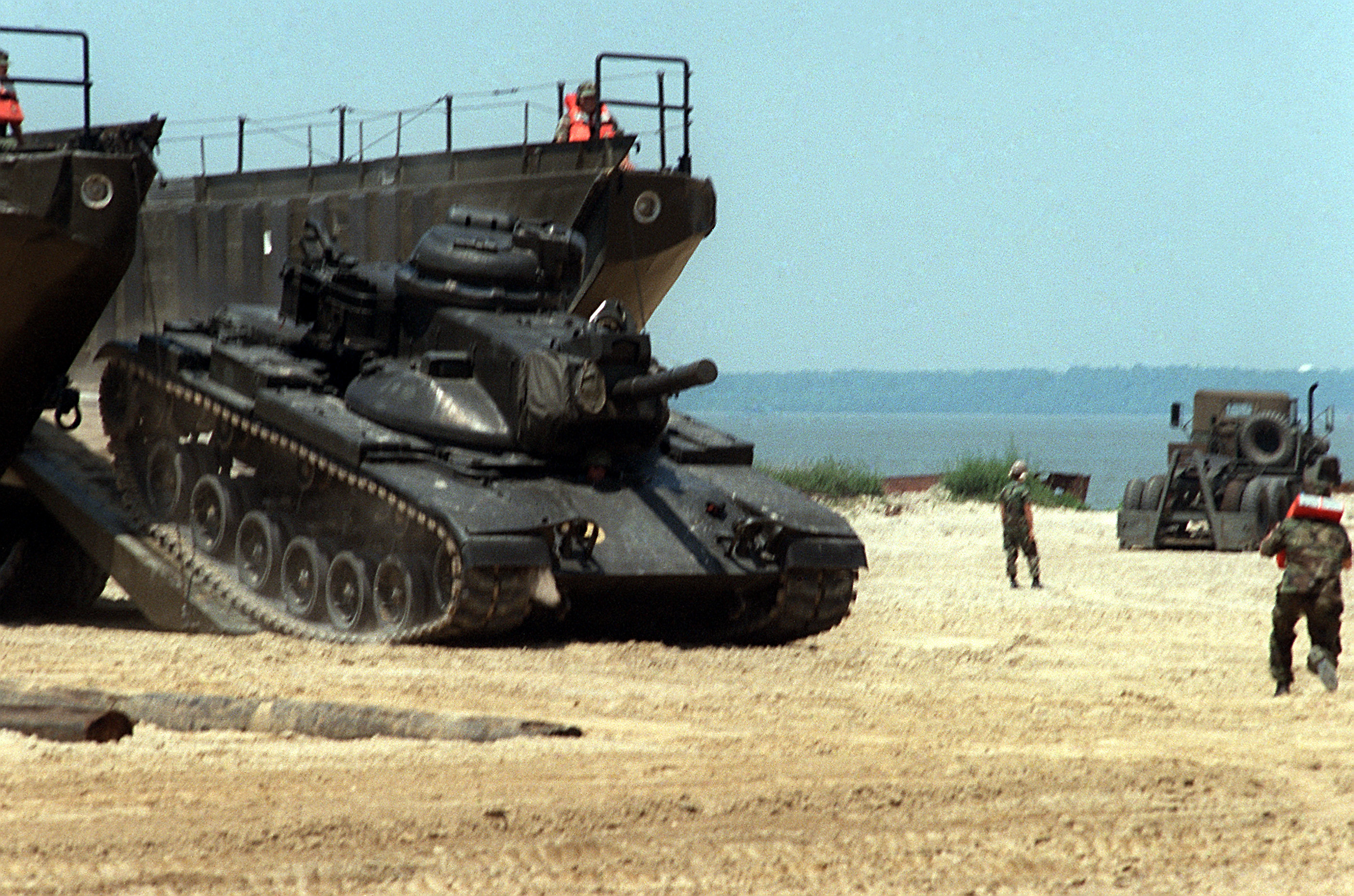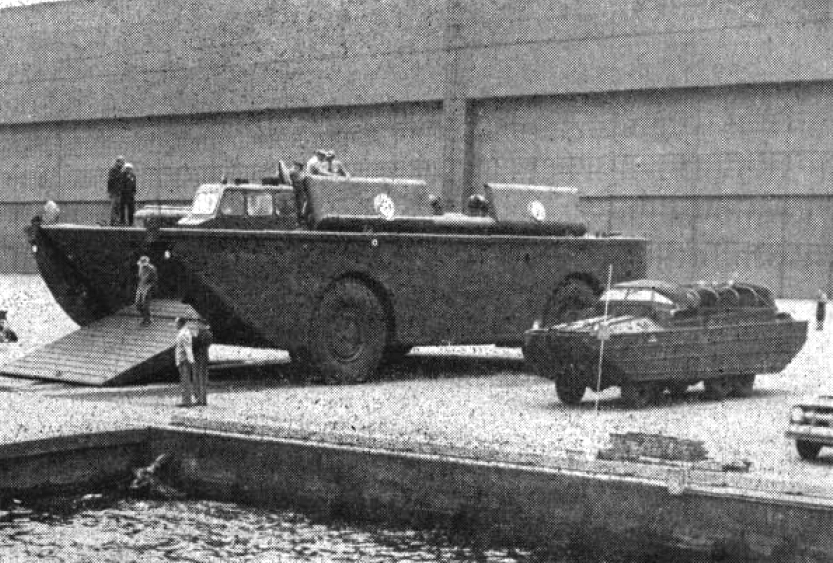LARC-LX on:
[Wikipedia]
[Google]
[Amazon]
The LARC-LX (Lighter, Amphibious Resupply, Cargo, 60 ton), originally designated as BARC (Barge, Amphibious Resupply, Cargo) is a welded


 It could carry up to 100 tons of cargo or 200 people, but a more typical load was 60 tons of cargo or 120 people. The vehicle was powered by four GMC
It could carry up to 100 tons of cargo or 200 people, but a more typical load was 60 tons of cargo or 120 people. The vehicle was powered by four GMC
LARC-LX
at GlobalSecurity.org {{Post-WWII US Soft Vehicles Wheeled amphibious vehicles Military vehicles of the United States Military vehicles introduced in the 1950s
steel
Steel is an alloy made up of iron with added carbon to improve its strength and fracture resistance compared to other forms of iron. Many other elements may be present or added. Stainless steels that are corrosion- and oxidation-resistant ty ...
-hulled amphibious cargo vehicle.
Description

 It could carry up to 100 tons of cargo or 200 people, but a more typical load was 60 tons of cargo or 120 people. The vehicle was powered by four GMC
It could carry up to 100 tons of cargo or 200 people, but a more typical load was 60 tons of cargo or 120 people. The vehicle was powered by four GMC diesel engine
The diesel engine, named after Rudolf Diesel, is an internal combustion engine in which ignition of the fuel is caused by the elevated temperature of the air in the cylinder due to mechanical compression; thus, the diesel engine is a so-call ...
s positioned in the sides of the hull, each of which drove one wheel on land. Pairs of engines were coupled to drive each of the two -diameter propellers, which propelled the vehicle in the water. Its top speed was on land, or afloat. The operator occupied a small cab on the port side at the aft end of the vehicle.
The LARC-LX was used to transport wheeled and tracked vehicles, including beach preparation equipment and general cargo, from ship-to-shore or to inland transfer points. It was also capable of transporting shipping containers, which could be landed from the LARC either by crane, straddle carriers, or rollers. It was the only amphibious vehicle in U.S. Army service capable of landing on a beach through surf. Typically, the LARC-LX was carried as deck cargo on a commercial vessel or heavy lift ship to be transported overseas. Surviving examples of the LARC-LX can be found at the Overloon War Museum
The Overloon War Museum (''Dutch: Oorlogsmuseum Overloon'') is located in Overloon, Netherlands.
The museum was opened on May 25, 1946, making it one of the oldest museums in Europe dedicated to the Second World War. The museum is located on ...
in the Netherlands, the Military Museum of North Florida in Green Cove Springs, Florida, the Lane Motor Museum
Lane Motor Museum is located in Nashville, Tennessee and features a collection of mostly European automobiles. The museum is a non-profit 501(c)(3) organization, founded by Jeff and Susan Lane, his father having founded the family's automotive ex ...
in Nashville, Tennessee, and the US Army Transportation Museum at Ft. Eustis, VA.
Service
The first BARC had its maiden voyage in 1952 atFort Lawton
Fort Lawton was a United States Army post located in the Magnolia neighborhood of Seattle, Washington overlooking Puget Sound. In 1973 a large majority of the property, 534 acres of Fort Lawton, was given to the city of Seattle and dedicated as ...
, Washington. The designation was changed from BARC to LARC in 1960. The LARCs first saw active service in 1967 when they were dispatched to South Vietnam
South Vietnam, officially the Republic of Vietnam ( vi, Việt Nam Cộng hòa), was a state in Southeast Asia that existed from 1955 to 1975, the period when the southern portion of Vietnam was a member of the Western Bloc during part of th ...
to support the 101st Airborne Division, and in 1968 the 1st Cavalry Division. The last LARC-LX vehicles were retired from service in 2001.
Specifications
*Crew: 5 *Weight: 100 tons *Engine: GM '' 6-71'', 265 hp × 4 *Range (land): *Range (sea): *Length: *Width: *Height: 19 ft, 6in *Wheelbase: 28 ft, 6 in *Battery: 24 volt *Speed (water) **Forward (empty): **Forward (60 ton): **Forward (100 ton): *Speed (land) **Forward (empty): **Forward (60 ton): **Forward (100 ton): **Reverse (60 ton): *Turning circle: 75 ft (23 m) *Gradient: 60% *Temperature range: 125 F to -25 F (-30 to +50 °C)See also
*LARC-V
LARC-V (Lighter, Amphibious Resupply, Cargo, 5 ton), is an aluminium-hulled amphibious cargo vehicle capable of transporting 5 tons. It was developed in the United States during the 1950s, and is used in a variety of auxiliary roles to this ...
– Lighter, Amphibious Resupply, Cargo, 5 ton – an aluminium-hulled vehicle.
* LARC-XV
LARC-XV (Lighter, Amphibious Resupply, Cargo, 15 ton), introduced in 1960, is an aluminium hulled amphibious cargo vehicle. It measures 45 by 15 feet and is powered by 2-300 hp engines.
About 100 were made with a small batch sent to Germany. ...
– Lighter, Amphibious Resupply, Cargo, 15 ton – an aluminium-hulled amphibious cargo vehicle.
External links
LARC-LX
at GlobalSecurity.org {{Post-WWII US Soft Vehicles Wheeled amphibious vehicles Military vehicles of the United States Military vehicles introduced in the 1950s